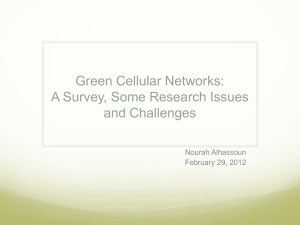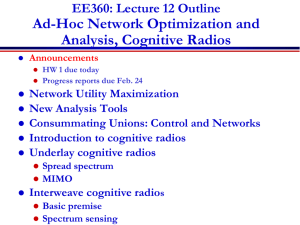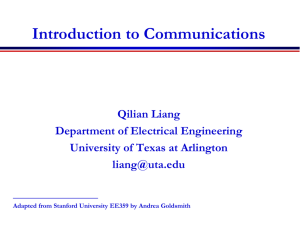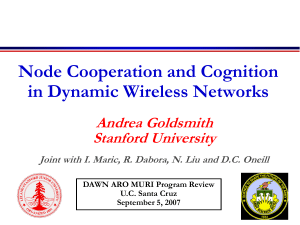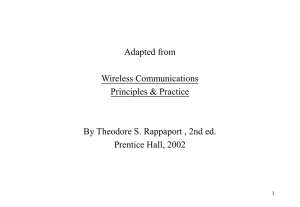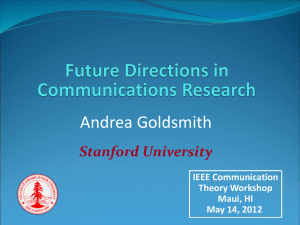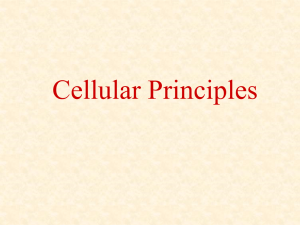The Road Ahead for Wireless Technology: Dreams and Challenges
advertisement
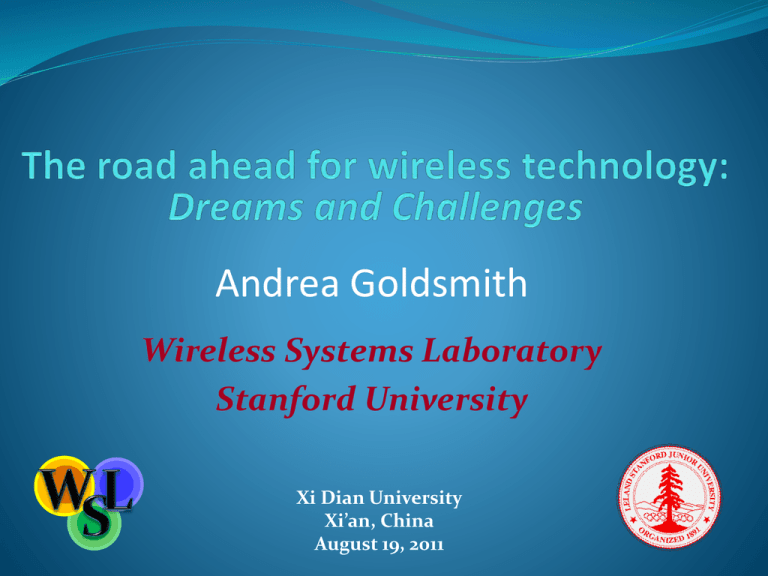
Andrea Goldsmith Wireless Systems Laboratory Stanford University Xi Dian University Xi’an, China August 19, 2011 Future Wireless Networks Ubiquitous Communication Among People and Devices Next-generation Cellular Wireless Internet Access Wireless Multimedia Sensor Networks Smart Homes/Spaces Automated Highways Smart Grid Body-Area Networks All this and more … Future Cell Phones Everything in one device Burden for wireless this performance is on the backbone network San Francisco BS BS Internet Nth-Gen Cellular Phone System Nth-Gen Cellular New York BS Much better performance and reliability than today - Gbps rates, low latency, 99% coverage indoors and out Future Wifi: Performance burden also on the Without (mesh) network Multimedia Everywhere, Wires 802.11n++ • Streaming video • Gbps data rates • High reliability • Coverage in every room Wireless HDTV and Gaming Device Challenges Size and Cost Multiband Antennas Multiradio Coexistance Integration BT Cellular FM/XM GPS DVB-H Apps Processor WLAN Media Processor Wimax Software-Defined (SD) Radio: Is this the solution to the device challenges? BT Cellular FM/XM A/D GPS DVB-H Apps Processor WLAN Media Processor Wimax A/D A/D DSP A/D Wideband antennas and A/Ds span BW of desired signals DSP programmed to process desired signal: no specialized HW Today, this is not cost, size, or power efficient Compressed sensing may be a solution for sparse signals Compressed Sensing Basic premise is that signals with some sparse structure can be sampled below their Nyquist rate Signal can be perfectly reconstructed from these samples by exploiting signal sparsity This significantly reduces the burden on the front-end A/D converter, as well as the DSP and storage Might be key enabler for SD and low-energy radios Only for incoming signals “sparse” in time, freq., space, etc. Scarce Wireless Spectrum $$$ Hence regulated, and expensive Spectral Reuse Due to its scarcity, spectrum is reused In licensed bands and unlicensed bands BS Cellular, Wimax Wifi, BT, UWB,… Interference: Friend or Foe? If treated as noise: Foe SNR P N I Increases BER, reduces capacity If decodable: Neither friend nor foe Multiuser detection can completely remove interference Ideal Multiuser Detection - Signal 1 = Signal 1 Demod Iterative Multiuser Detection Signal 2 Signal 2 Demod - = Why Not Ubiquitous Today? Power and A/D Precision Reduced-Dimension MUD Exploits that number of active users G is random and much smaller than total users (ala compressed sensing) Using compressed sensing ideas, can correlate with M~log(G) waveforms Reduced complexity, size, and power consumption 10% Performance Degradation Linear Transformation 1 Tb Tb 0 0 c1 h1 ( t ) r(t) 1 g1 t Tb 2 g 4 t n (t) Tb Decision b˜ 2 b˜ i c2 h2 (t) M 1 Tb Decision b˜1 a Tb c M 0 hM (t) j 1 ij c j b˜ N Decision Interference: Friend or Foe? If exploited via cooperation and cognition Friend Especially in a network setting Rethinking “Cells” in Cellular Coop MIMO Femto How should cellular systems be designed? Relay DAS Will gains in practice be big or incremental; in capacity or coverage? Traditional cellular design “interference-limited” MIMO/multiuser detection can remove interference Cooperating BSs form a MIMO array: what is a cell? Relays change cell shape and boundaries Distributed antennas move BS towards cell boundary Femtocells create a cell within a cell Mobile cooperation via relaying, virtual MIMO, analog network coding. Gains from Distributed Antennas 10x power efficiency gain with 3 distributed antennas 3-4x gain in area spectral efficiency Small cells yield another 3-4x gain DAS ---- Optimal Placement ---- Random Placement ---- Central Placement Cooperation in Ad-Hoc Networks Similar to mobile cooperation in cellular: Virtual MIMO , generalized relaying, interference forwarding, and one-shot/iterative conferencing Many theoretical and practice issues: Overhead, half-duplex, grouping, dynamics, synch, … Generalized Relaying TX1 RX1 Y4=X1+X2+X3+Z4 X1 relay Y3=X1+X2+Z3 TX2 X3= f(Y3) X2 Analog network coding Y5=X1+X2+X3+Z5 RX2 Can forward message and/or interference Relay can forward all or part of the messages Much room for innovation Relay can forward interference To help subtract it out Beneficial to forward both interference and message In fact, it can achieve capacity P1 S P3 Ps D P2 • P4 For large powers Ps, P1, P2, analog network coding approaches capacity Intelligence beyond Cooperation: Cognition Cognitive radios can support new wireless users in existing crowded spectrum Without degrading performance of existing users Utilize advanced communication and signal processing techniques Coupled with novel spectrum allocation policies Technology could Revolutionize the way spectrum is allocated worldwide Provide sufficient bandwidth to support higher quality and higher data rate products and services Cognitive Radio Paradigms Underlay Cognitive radios constrained to cause minimal interference to noncognitive radios Interweave Cognitive radios find and exploit spectral holes to avoid interfering with noncognitive radios Overlay Cognitive radios overhear and enhance noncognitive radio transmissions Knowledge and Complexity Underlay Systems Cognitive radios determine the interference their transmission causes to noncognitive nodes Transmit if interference below a given threshold IP NCR NCR CR CR The interference constraint may be met Via wideband signalling to maintain interference below the noise floor (spread spectrum or UWB) Via multiple antennas and beamforming Interweave Systems Measurements indicate that even crowded spectrum is not used across all time, space, and frequencies Original motivation for “cognitive” radios (Mitola’00) These holes can be used for communication Interweave CRs periodically monitor spectrum for holes Hole location must be agreed upon between TX and RX Hole is then used for opportunistic communication Compressed sensing reduces A/D and processing requirements Overlay Cognitive Systems Cognitive user has knowledge of other user’s message and/or encoding strategy Can help noncognitive transmission Can presubtract noncognitive interference CR NCR RX1 RX2 Performance Gains from Cognitive Encoding outer bound our scheme prior schemes Only the CR transmits Cellular Systems with Cognitive Relays Cognitive Relay 1 data Source Cognitive Relay 2 Enhance robustness and capacity via cognitive relays Cognitive relays overhear the source messages Cognitive relays then cooperate with the transmitter in the transmission of the source messages Can relay the message even if transmitter fails due to congestion, etc. Can extend these ideas to MIMO systems Wireless Sensor Networks • • • • • • Smart homes/buildings Smart grid Search and rescue Homeland security Event detection Battlefield surveillance Energy (transmit and processing) is the driving constraint Data flows to centralized location (joint compression) Low per-node rates but tens to thousands of nodes Intelligence is in the network rather than in the devices Cross-Layer Tradeoffs under Energy Constraints Hardware Link High-level modulation costs transmit energy but saves circuit energy (shorter transmission time) Coding costs circuit energy but saves transmit energy Access All nodes have transmit, sleep, and transient modes Each node can only send a finite number of bits Power control impacts connectivity and interference Adaptive modulation adds another degree of freedom Routing: Circuit energy costs can preclude multihop routing Total Energy (MQAM) Green” Cellular Networks Pico/Femto Coop MIMO Relay DAS How should cellular systems be redesigned for minimum energy? Research indicates that signicant savings is possible Minimize energy at both the mobile and base station via New Infrastuctures: cell size, BS placement, DAS, Picos, relays New Protocols: Cell Zooming, Coop MIMO, RRM, Scheduling, Sleeping, Relaying Low-Power (Green) Radios: Radio Architectures, Modulation, coding, MIMO Antenna Placement in DAS Optimize distributed BS antenna location Primal/dual optimization framework Convex; standard solutions apply For 4+ ports, one moves to the center Up to 23 dB power gain in downlink Gain higher when CSIT not available 6 Ports 3 Ports Distributed Control over Wireless Automated Vehicles - Cars/planes/UAVs - Insect flyers Interdisciplinary design approach • • • • Control requires fast, accurate, and reliable feedback. Wireless networks introduce delay and loss Need reliable networks and robust controllers Mostly open problems: Many design challenges Wireless and Health, Biomedicine and Neuroscience Body-Area Networks Doctor-on-a-chip -Cell phone info repository -Monitoring, remote intervention and services Cloud The brain as a wireless network - EKG signal reception/modeling - Signal encoding and decoding - Nerve network (re)configuration Summary The next wave in wireless technology is upon us This technology will enable new applications that will change people’s lives worldwide Design innovation will be needed to meet the requirements of these next-generation systems A systems view and interdisciplinary design approach holds the key to these innovations
